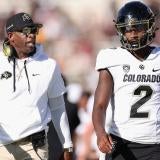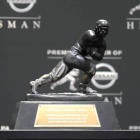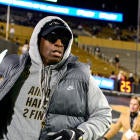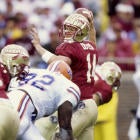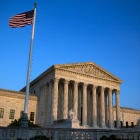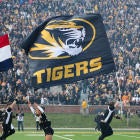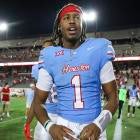This week's Friday Five is inspired by a different story I wrote earlier this week. I wrote a story on the greatest teams in the history of each Big Ten school, and it was while researching this piece that an old flame began to burn a bit brighter.
I knew I was going to write about the 1995 Nebraska team for the story because it was the greatest Nebraska team of all time, and had one of my favorite players of all time: Tommie Frazier. This opened up an old wound that reminded me of how angry I was when Frazier finished second in the Heisman Trophy voting to Eddie George that season. This then led to me thinking about other Heisman snubs, and here we are with this week's Friday Five topic.
The greatest Heisman snubs in college football history.
To compile this list, I set a few rules for myself. I didn't want professional careers to impact how I felt about the Heisman in retrospect. Also, I tried to distinguish between "deserving" and "snubbed." Plenty of players deserved to win the Heisman in their time but lost to other players who had better or similar seasons. Which is why I won't be including anybody from 1997 on this list. Hell yes, Peyton Manning and Randy Moss deserved to win the Heisman for their performances in 1997, but you know what? So did Charles Woodson. And if you think I'm going to take away the Heisman from the lone defensive player to win it in the modern era, then you don't know a whole lot about me.
So keep that in mind while going through this list.
5. Tommie Frazier, QB, Nebraska, 1995: Frazier inspired this list, but I'm not putting him at No. 1. The reason for this is that, while I think Frazier deserved the award more, it's not like George had an awful season. He was good. It's just, Frazier was the most important player and the most dominant player on a team that was a level above its competition that season. Seriously, No. 1 Nebraska played No. 2 Florida in the Fiesta Bowl that season and beat it by 38 points. The Huskers won all their games by an average of 38.7 points. They don't do that without Frazier!
Meanwhile, George and the Buckeyes dropped their final two games of the season. And in the regular season against Michigan -- the last game before voting -- George rushed for 104 yards on 21 carries. Not bad, but Michigan's Tim Biakabutuka rushed for 313 yards in the same game. There was never a Nebraska game that season where Frazier wasn't the best player on the field. I could argue that George was never the best player on his offense (hello, Orlando Pace).
4. Adrian Peterson, RB, Oklahoma, 2004: Peterson fell victim to a couple of traps in 2004. The biggest being that he was a freshman. Freshman didn't win the Heisman. When Tim Tebow won the award as a sophomore three years later, it was seen as a breakthrough. Then, Johnny Manziel won it as a redshirt freshman in 2012.
So Peterson was a bit ahead of his time here.
Also, he just happened to have an incredible season for a freshman (1,937 total yards, 15 TD) in a year that USC was winning a national title, so the award was given to Matt Leinart. Now, Leinart didn't have a lousy season (3,332 yards, 33 TD), but they weren't incredible numbers. He finished 15th nationally in yards per attempt and 12th in completion percentage. Peterson, meanwhile, led the nation in carries and finished third in yards as a freshman. Had Peterson had the same season (he rushed for at least 100 yards in 11 of Oklahoma's 13 games) but been a junior, he'd have won the award. Oklahoma doesn't reach the title game against USC without him. Can you make the same argument for USC without Leinart considering all the talent on that team? I'm not sure.
3. Marshall Faulk, RB, San Diego State, 1992: Faulk was found guilty of being a player at a WAC school in 1992. OK, so the fact that his WAC school also finished 5-5-1 in 1992 didn't help, either, but it sure as hell wasn't Faulk's fault.
Faulk finished the season with 1,758 yards from scrimmage and 15 total touchdowns. His 1,630 rushing yards led the nation. Heisman winner Gino Torretta played quarterback for the team that was No. 1 at the time of voting, but would lose to Alabama in the Sugar Bowl 34-13. On the season, Torretta threw for 3,060 yards and 19 touchdowns. It was the lesser of his two seasons as a starter for the Canes. His completion percentage of 56.7 wasn't good enough to finish in the top 25, and his 7.6 yards per attempt finished in a tie for 16th. He just threw the ball more often than most quarterbacks (only five other QBs had more pass attempts than Gino's 402) at the time and did so on a team that was one of the best in the country.
This was one of those years when a player at a prominent position on a great team won the award instead of the best player.
2. Chuck Muncie, RB, California, 1975: Ohio State running back Archie Griffin is the only player in college football history to win consecutive Heisman Trophies. Well, I'm here to tell you that he shouldn't have won the second one.
In 1975, there was a running back that amassed 1,620 yards from scrimmage, averaged 5.9 yards per touch, and scored four touchdowns. There was another running back that season that had 1,852 yards from scrimmage, averaged 6.9 yards per touch, and scored 15 touchdowns. Guess which one was given the Heisman.
If you guess the one who had the worse numbers, you're correct! That was Griffin. The second back was Cal's Muncie. Muncie also threw two touchdowns that season. His mistake was playing at Cal, which finished 8-3, but played on the west coast and didn't get nearly any attention.
He deserved the award more than Griffin did. Hell, you could argue that Griffin's teammate Pete Johnson (1,059 yards, 25 touchdowns!) earned the award more than he did that season.
You could also argue that USC RB Ricky Bell or Pitt's Tony Dorsett deserved the award more than Griffin did that season too.
The point is that Griffin deserved the award in 1974, and apparently, some voters felt he did such an excellent job in 1974 that they wanted to give him the award again in 1975.
1. Larry Fitzgerald, WR, Pittsburgh, 2003: It has always been an uphill battle for wide receivers in the Heisman race. Even now, when offenses are more passing-oriented than ever before, the receiver gets little love. Fortunately, I'm here to love the hell out of what might have been the greatest single season from a wide receiver in college football history.
Playing on a rather mediocre Pitt team in 2003, in which he was the only real threat on the entire offense, and had to face defenses who didn't worry about anybody but him, Fitzgerald caught 92 passes for 1,672 yards and 22 touchdowns. Fitzgerald's 1,672 receiving yards were 168 more than the next closest receiver in the country, and his 22 touchdowns were six more than anybody else scored. And he did all this while facing double-coverage at a minimum. He was amazing.
So who won the award instead? Oklahoma QB Jason White. Now, context is relevant here. The 2003 season was still early in the Air Raid/spread renaissance that has become so prevalent in the sport today, so we weren't used to seeing some of the numbers QBs were posting. White finished the season with 3,846 passing yards, but it was the 40 touchdowns that grabbed your attention. The problem is that those 40 touchdowns were only good enough for second in the country. Texas Tech's QB B.J. Symons (hello, Mike Leach) threw 52. As for his yardage total, White finished seventh in the nation in yards, 20th in completion percentage, and 14th in yards per attempt. Also, in White's final two games of the season against Kansas State in the Big 12 Championship and LSU in the Sugar Bowl, he was a combined 40-of-87 passing (45.9 percent) for 400 yards, no touchdowns and four interceptions.
The final vote shouldn't even have been close.
Honorable Mention: O.J. Simpson, RB, USC, 1967; Herschel Walker, RB, Georgia, 1980; Champ Bailey, CB, Georgia, 1998; LaDainian Tomlinson, RB, TCU, 2000; Ndamukong Suh, DT, Nebraska, 2009











